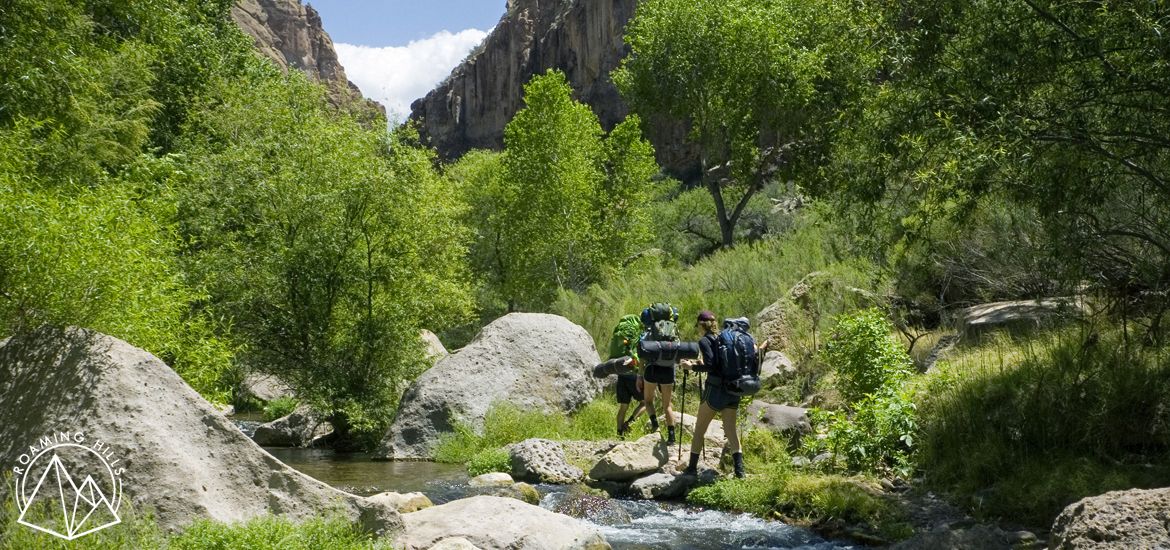Is the pack heavy?
What if I forget something?
How much water do I bring?
How many times do I need to re-pack before I look like an outdoorsy Instagram babe instead of a overwhelmed weirdo strapped to a giant lumpy pillow?
It’s running through your mind, and it ran through mine. Anyone who’s headed the call of the wild and decided to take a relationship with camping to the next level has pondered over this.
Car camping is beautiful in its abundance: Boom box? Backseat. Seven changes of clothes? Backseat. Way too much beer? In the giant cooler, obviously in the backseat. But backpacking is an entirely different love song to nature, an overture of dependence, toil and simplicity. And the startling realization of how much crap you need to spend a night outside.
Back in the spring, I gleefully accepted an invitation to traverse six miles into Aravaipa Canyon, a creek-crossing adventure in Arizona’s southern wilderness. Here are the takeaways from my first trip to reassure any of you backpacking beginners.

Get the right gear for you
Welcome to the inverted world of backpacking gear, where less is more. Lightweight packs, sleeping bags and tents rack up astronomical prices compared to their car-camping variations that boast twice as much room and fabric. But hey, you know the saying. You get what you pay for, right?
My advice to you, as a beginner: You don’t need to pay for top-tier gear.
If you’re the kind of hobbyist that comes at new endeavors with fist-fulls of cash to buy the best and newest, more power to you. But this section contains shaming of full-price outdoor retail and alternatives for comfort and functionality on a budget.
Your process for purchasing gear might go something like this. Head to your local REI. Pick up a svelte sleeping pad that self inflates and reduces down to the size of a $100 bill. See price tag indicating it will take two of those types of bills to walk out with it, place back on shelf, and mutter to yourself.
Now, find stuff on sale or used. You can even go on Amazon and buy it for a quarter of the price. There are some awesome outdoor retailers there that put effort into designing lightweight products for those of us not committed to forking over a tax return’s worth of tiny tents and little chairs made of a swath of fabric pulled over collapsible poles.
Here’s what I got before my trip:
- Pack: Osprey Aura AG 65. I shelled out for this brand new for $190, but only because I got a discount. It’s a really great pack.
- Tent: Marmot 2 person Tungsten. Bought for $100, half of its retail price, from a guy on OfferUp that it lugged it out only once.
- Sleeping bag: OutdoorsmanLab Mummy Sleeping Bag. 3 seasons, 3 pounds, $35. Time spent putting back into compression sack: Priceless.
- Sleeping pad: OutdoorsmanLab Ultralight Sleeping Pad. 40 bucks for a fluorescent tongue of padding that inflates in a few breaths, and didn’t suck for comfort. REI prices for these run up to $200.
- Chairs: Marchway Ultralight folding chairs. $30 instead of REI’s $80, and only 6 ounces heavier.
- Hydration bladder: WACOOL 3-liter reservoir, $17. Your pack doesn’t come with this, and you need it so you can drink water and not die.
- Trekking poles: Snowy Mountain Traders aluminum poles. What’s better than two legs? Four. And you can stick these extra two legs wantonly in rocks and mud, and use them to prevent getting smacked by a tree branch by the people walking in front of you. Buy them for $40 instead of $100.
- Water filter: Survivor Filter PRO. We ended up using this extensively, although the pump process is a little slow-going.
- Jetboil: Ok, popular brand-name things can be nice. I got this as a gift and it worked great.
- Utensils: Sea to Summit Delta Cutlery Set for $10.
- Food: Backpacker’s Pantry Dinners. For plant-based eaters like myself, the selection of freeze-dried vegan dinner picks is outstanding. I eschewed plating of any kind and ate directly out of the bag, hunched over in my seat and grunting like a caveman.
- Potty trowel: The Deuce Ultralight. For reasons.
Here is what I already owned and brought along:
- Headlamp.
- Solar-powered collapsible lantern.
- Knife.
- Daypack. Carry this around when you explore after setting up camp.
- Pillowcase. I stuff this with my clothes.
- Camp sandals. We hiked in through a creek, so it was nice to change into different dry shoes.
- Snacks. Snacks on snacks on snacks.
- Toothbrush and toiletries.
- Hat.
- First aid kit.
- Camera.
- Bag for garbage.
What I wish I had brought:
- Booze. Can someone figure out how to freeze-dry beer?
- Stuff sacks. As I got everything laid out, I discovered my need for sacks to combine and organize a lot of the little stuff I mentioned above.
- Bear cannister/rope. Luckily someone else had this and new how to use it.
- Water filter as a squeezable pouch. This is way faster and easier than a pump for filtration.
I didn’t need:
- So many clothes. I brought way too many for one night, and prepared for it to be much colder than it was. Limit yourself—clothes are bulky and you’re going to be smelly anyway, so just pack essentials.
- So much food. I guess it’s better to come over-prepared in this department, but remember that I brought snacks on snacks on snacks? I just probably needed ‘snacks.’

Pack and re-pack in advance
My husband wanted to dig right into stuffing in the goods. I wanted to prepare with videos and pictures of neatly arranged piles of things going in the bag. Turns out a combination of using your resources and trail-and-error works best.
I got a great tip from a gal on Youtube: For bags with a sleeping bag compartment at the bottom, there are pockets of space created on the sides for items like your Jetboil propane. We also learned about using the “brain” or top zip on your pack to hold necessities you need to access more quickly.
But it really comes down to your pack and your gear. It’s a puzzle of stuffing and swearing. Try it several times the night before you head out to get comfortable.
Settle in for the haul
The first time you swing your pack on and are embraced lovingly by the waist straps, don’t panic about the weight. Get situated, cinch everything tightly, and trust in the balance and weight distribution. My big realization was that after hiking with 25 extra pounds, you adjust after the first hour, or couple of miles.
This is your life now. You are a fearless packer, face set in grim determination with maybe a hint of a smile. You inspire awe into the families with little kids playing in the creek as you pass by (“so adventurous,” mutters mom). You swing your trekking poles to the rhythm coming from your group’s bluetooth speaker.
And, inexplicably, it’s almost harder to stop than it is to just keep hiking. We paused for a snack break and chance to soak in the cool creek, and hefting the bag off and on was worse than the actual trek. When we reached a potential camp spot and deliberated moving on to see what else was down the canyon, I just wanted to keep hiking. I was fueled with purpose, like how you give high-energy working dogs a pack to wear or something to pull.
But when you do finally stop for camp and dry out the back sweat, it feels oh so rewarding.

Keep it neat
Don’t play into the temptation to let things go while you’re at camp. You know what I mean. Clothes strewn everywhere inside the tent. A bag of toiletries dumped hastily to find your toothpaste. Compression sacks discarded into corners. How did a KIND bar wrapper get in here?
The more you stay on top of keeping your gear organized, the easier it will be to inevitably repack the beast on your back when you leave. This is why stuff sacks are so important.
Enjoy yourself
Open skies, plentiful stars, a full moon, friendly faces lit with fire, the constant shhhh of the distant creek. It’s camping, but you also just walked all your own stuff in here. That’s pretty awesome. Enjoy it, even without the cooler of beer or the Spikeball set.
Expect to be sore
Soreness sneaks up on you. You won’t even totally feel it the morning after your hike in. Your body accepts the now familiar weight of the pack and steps up for the challenge of returning. My greatest struggle was an exposed uphill climb in creeping afternoon temperatures, right before we hit the parking lot.
At this point I thought, “I did it.” When I emerged from my seat in the car after the three-hour drive back into civilization, my entire muscular system said, “Yeahhh, you did!” Our carload stumbled out with groans and pains in places previously unbeknownst to us. The weirdest bodily meltdown was the soreness in the crook of my arm from planting and plucking the trekking poles.
So don’t plan to do anything serious in the hours after you get back. Unless it’s sitting on your phone planning on where you want to go backpacking next.
Ha ha, you’re hooked.
⛰
LIFE’S A TRAIL…
So, every week I send out a fun & inspiring story to my subscribers in my newsletter, Trail Ratings. Get it!


